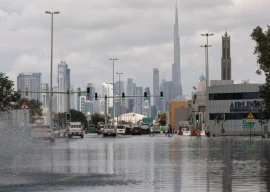
HYDERABAD:
Criticism over the Sindh Water Sector Improvement Project (WSIP) and identifying shortcomings in an ongoing study by a consultancy dominated a workshop held on Thursday.
The Louis Berger Group (LBG) was tasked by WSIP to do a five-year study in the left bank districts of the River Indus, delta and coastal zone in Sindh. The event was attended by water, engineering and environment experts, farmers and civil society representatives, as well as officials of WSIP, Sindh Irrigation Drainage Authority and consultants from LBG. A number of issues were discussed including drainage, flood and storm water disposal, degradation of environment and natural resources and the socioeconomic situation in the Nara Canal Area Water Board region which spreads across Nawabshah, Mirpurkhas, Sanghar and Tharparkar districts. The region covers a cultivable area of 21.74 million acres.
Prof Ghulam Rasool Keerio, an environment consultant at LBG, read from a 66-page presentation which briefly covered fisheries, forests, agriculture, industrial effluents, tube wells, and containing seepage from Chotiari Dam in Sanghar, among other issues. But his presentation could not give an insight into the estimated capacity of these storage and disposal sites and invited questions and criticism.
“It totally omits the people displaced and affected by the Left Bank Outfall Drain (LBOD) and other flaws in the irrigation system,” said Zulfiqar Halepoto of the Thardeep Rural Development Programme. “This overarching study should also take care of the legal and constitutional frameworks in view of the devolved irrigation subjects after the passage of the 18th amendment.”
Prof Bakshal Lashari of the Mehran University of Engineering and Technology advised against using the excessive rains of 2011 and the floods in 2010 as the basis of a long-term strategy, since he believes these weather patterns occur once in a century. “While necessary infrastructure and planning is indispensable, the government also needs to avoid spending lavishly on projects which may not be worthwhile.” He questioned the LBG’s suggestions to contain seepage from Chotiari dam. “It is the soil of the area which is the problem. A concrete fence can’t plug the leak.” The dam, which was built in 2002, has a storage capacity of around 0.71 million acres feet.
Muhammad Ayub Wassan, a grower from Sanghar, asked about the irrigation authorities’ short-term plans to tackle possible flooding after the 2012 monsoon rains.
“As part of the larger drainage plan for the province, there is a broad consensus to revive the historic drainage disposal sites called dhora as well as the lakes that were rendered rendered obsolete,” Keerio said.
Alternatives like the LBOD were linked with the secondary and tertiary drains have replaced the natural flows.
But the presentation showed that dhoro Puran and Digri dhoro in Mirpurkhas, Naro, Pithoro and Nabisar dhora in Umerkot and Shahdadpur-Tando Adam dhoro in Sanghar can be linked to the LBOD to reduce pressure from the drain and to deal flooding.
The off stream reservoirs are an option for water storage. “The 1271-acre Kalankar lakes and Kako lakes in Umerkot to the east of Nara Canal and 308-acre Jamrao lakes in Mirpurkhas, to name a few, are potential water storage facilities,” Keerio said. At least three Ramsar sites in Sindh including Deh Akro II wetland in Nawabshah, Chotiari and Achro wetlands in Tharparkar and coastal wetlands in Badin and Thatta also demand attention. “Deh Akro, which is an aggregate of several lakes, has a high crocodile population. Since it is not connected with an irrigation system, the lakes remain dry for most of the year,” Keerio said, suggesting that linking these sites with irrigation system will have a dual advantage. “The lakes will not dry up and storm water will also have a disposal route.”
The LBG collected recommendations in writing from the participants after the workshop. Its ongoing study consists of solutions and long-term strategies and also includes suggestions from stakeholders.
Published in The Express Tribune, January 1st, 2012.
COMMENTS (1)
Comments are moderated and generally will be posted if they are on-topic and not abusive.
For more information, please see our Comments FAQ












































good coverage of a very important issue